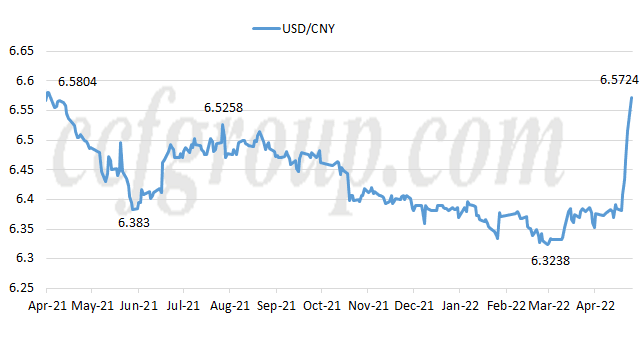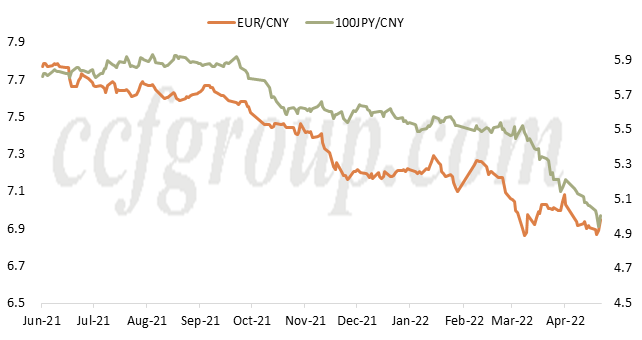Why Chinese yuan depreciates sharply ?
Chinese yuan has reversed its continuous strong trend and depreciated significantly against the US dollar. Both onshore and offshore yuan , breached the key 6.55 per US dollar, touching their weakest levels since April 2021. The onshore yuan finished at 6.5544 per US dollar, the weakest close since Apr 9, 2021.

Compared with the Japanese yen and even the euro, the trend of the yuan is still relatively strong.

The dollar often serves as a haven during periods of geopolitical uncertainty and unsettled markets. The strong US dollar is driven by a series of factors such as risk aversion and interest rate hike expectations. Of course, China is also facing own headwinds.
1. Risk aversion
The depreciation of the RMB against the US dollar started in March, when the conflict between Russia and Ukraine broke out. The dispute between the two countries has developed into a military conflict. More and more countries has involved, which has evolved into a larger-scale international political event. Since then, Europe and the United States have sanctioned Russia and expelled it from the SWIFT system, resulting in major impacts on the international energy, agriculture, and financial systems. Driven by the demand for risk aversion, the US dollar has naturally risen as a safe-haven asset.
In this conflict, Europe has been the hardest hit due to the sharp rise in costs, its dependence on raw materials for energy, and the influx of refugees. Expectations of economic weakness have dragged down the euro, and the Japanese yen has been under pressure over the same period, boosting the US dollar accordingly.
2. Interest rate hike expectations
A strong hawkish Fed
In the high inflation in 2022, central banks across swaths of the globe are continuing to raise interest rates in an effort to tame inflation. Fed officials have made hawkish remarks on different occasions to push interest rate hikes higher. At present, market expects to raise interest rates by 50 basis points in May (some even expect 75 basis points), and there is a high probability that interest rates will continue to rise in June and July. In this context, the central banks of Canada and New Zealand have taken the lead in raising interest rates by 50 basis points recently.
The cautious European Central Bank
However, unlike the Fed, the European Central Bank, as an influential economies, is obviously more cautious. European Central Bank President Christine Lagarde has repeatedly stressed that he does not see signs of stagflation and will maintain the flexibility of policy.
The difference in attitudes between Europe and the United States comes from the difference in fundamentals:
The United States dares to raise interest rates at a time of high inflation because its unemployment rate has hit record lows, with the latest value of 3.6%, which has already met the basic requirements for full employment. In fact, the recent positive real yields on U.S. Treasuries suggest that the increase in yields has exceeded inflation expectations, which means that investors believe that the Fed has the ability to gradually reduce inflation while keeping the economy strong.
However, the Eurozone is different. At present, the conflict between Russia and Ukraine has dragged down the economic growth prospects. The comprehensive unemployment rate in the euro area is already at a high of 6.8%. Higher interest rates may lead to a further increase in the unemployment rate. As a result, the European Central Bank faces more difficult choices. At present, the market's expectation for the ECB to raise interest rates is as early as July, which means that the euro will remain relatively weak against the US dollar before that.
The Bank of Japan in the opposite direction
Japan is a more extreme example. In order to achieve the inflation target and protect the fragile economy, Bank of Japan Governor Haruhiko Kuroda has repeatedly reiterated that he will not hesitate to step up easing if necessary, but this has also caused the yen to plummet, and become the weakest international reserve currency.
3. China: uncertainty lingers
For China, it is also facing a more complicated situation. Under the influence of the recent epidemic prevention and control, the manufacturing and service industries have been significantly affected. In order to ensure a stable increase in economic, work and production are being resumed in an orderly manner, but there are still uncertainties in the future.
Against this background, the National Standing Committee also pointed out that stabilizing growth should be placed in a more prominent position, making overall plans to stabilize growth, adjusting the structure, and promoting reforms. Policies for stabilizing the economy should come out early and quickly, and there are no measures that are not conducive to stabilizing market expectations, and make plans to deal with greater uncertainty.
However, when it comes to monetary policy, the current stimulus policy is mainly considering cutting required reserve ratios rather than interest rates for the time being, mainly considering the safety margin of the of the interest rate gap between China and the United States.
It can be seen that the current 10-year Treasury bond yields between China and the United States are very close, and as the Fed decides to raise interest rates in the future, this spread will inevitably widen. Although the spread cannot determine all issues, at least the pressure on capital outflows cannot be ignored, which is also reflected in the recent stock market reaction.
| Assets | Latest prices | change | Change (%) |
| US10YR.OTC | 2.826 | -0.08 | -2.77% |
| CN10YR.OTC | 8.839 | -0.007 | -0.25% |
| JR10YR.OTC | 0.246 | 0.001 | 0.00% |
| UK10YR.OTC | 1.891 | -0.073 | -3.72% |
In general, central banks must balance multiple factors such as exchange rates, growth, and inflation. Judging from the current situation, under the circumstances that the Fed's interest rate hike, the phased strengthening of the US dollar is still the main trend in the near future. The unexpected variables may mainly focus on whether the US economic data suddenly deteriorates, leading to a downward of the rate hike process expectations, and whether the European Central Bank's attitude has significantly reversed.
Of course, the impact of RMB depreciation can also be seen in a positive sense, it is also conducive to the recovery of exports, especially after the appreciation of renminbi in the past two years, there is also buffer space for phased adjustment.
- Top keywords
- Cotton Price
- Cotton Futures Price
- Cotton Futures
- CZCE
- PTA Futures Price
- Chemical Fiber
- Polyester Prices
- Wool price
- PTA Futures
- Shengze Silk
- China
- Yarn Price
- price
- China Textile City
- Fibre Price
- Benzene Price
- Cotton
- Index
- Cotton Index
- PTA
- fabric price
- NYMEX
- Top 10
- textile industry
- Spot Cotton
- Cotton Yarn
- Polyester Price
- Futures
- PTA Price
- cotton yarn price

